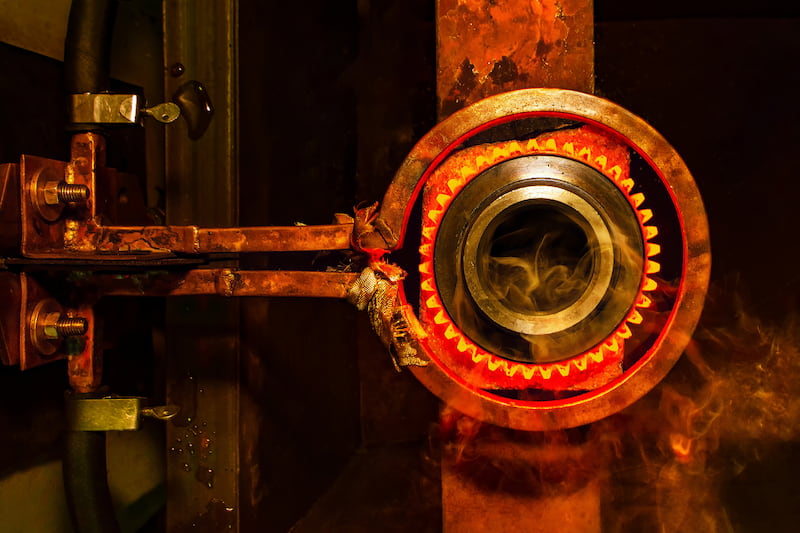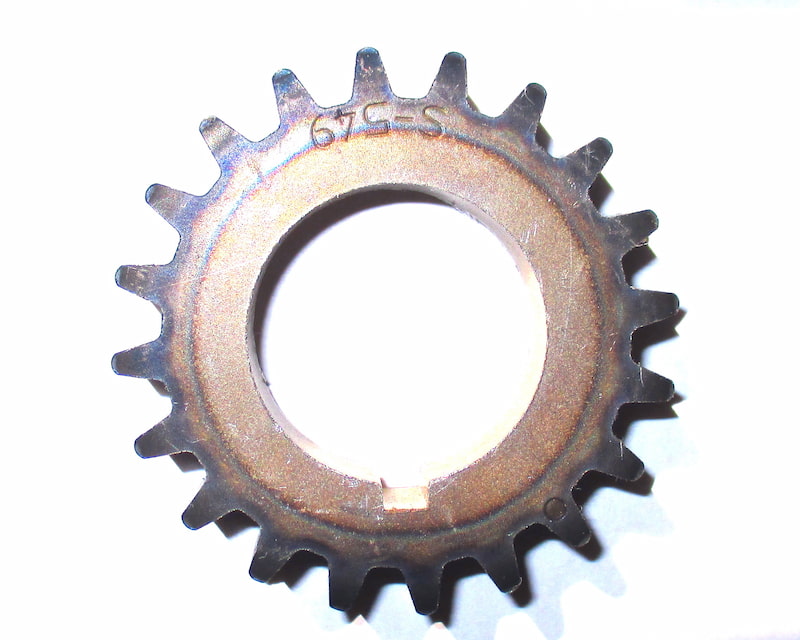Case hardening is a metallurgical process that allows us to create special parts with unique properties. In this article, we explore what it is, its process and its applications.
What Is Case Hardening?
Case hardening is a heat treatment process that hardens the surface of a metal substrate while maintaining a softer core. This allows to combine the best properties of a soft and hard metal into one part.
A soft material can handle impact forces much better than a hard material. It is also tougher, more ductile and stronger but it does not have sufficient wear resistance. Good wear resistance is crucial to ensure that the material does not wear away due to abrasion or friction. By hardening just the outer surface, we can significantly reduce the wearing of material without compromising other properties.
We can achieve the thin hardened surface through different means such as altering the crystal structure and/or the addition of new elements to the surface. But no matter the process, case hardening almost always requires elevated temperatures.
When Is Case Hardening Used?
We use case hardening when we need to improve the surface hardness of softer materials such as iron or low-carbon steel parts. The standard practice is to do it after all the machining and forming operations as it reduces the machinability of a part. But we may also do it during earlier stages of the manufacturing process. Some of the instances where case hardening procedure is used are as follows:
Low Budget
There is a significant price difference between low-carbon steel and tool steels such as high-speed steel. The difference can be more than 20x in some cases. Thus, when the budget is a concern, we can use case-hardened low-carbon steel instead of tool steel.
Also, case hardening requires less energy and time compared to through hardening as you do not harden the entire cross-section. Thus, along with the raw material cost, we can also save resources in manufacturing.
Unique Properties
The combination of a soft interior core with a hard outer layer provides unique properties as discussed in the earlier section. Case hardening allows us to take advantage of these properties. Case-hardened couplings are examples of parts that provide durability as well as strength. They can handle small misalignments much better than through-hardened parts.
Reduced Material availability
When material availability is an issue, we can opt for case-hardened low-carbon steel; especially in non-critical applications. Many places do not have the required tool steel grades available in different sizes. The only way to obtain it, in that case, is to buy a much bigger size than required. So instead of buying that, we can buy low-carbon steel and get it case-hardened for our applications.
Application-based use
The application sometimes requires only a hard surface. In such cases, instead of through hardening, we can go for just surface hardening. Suitable examples are files, bolts and gears.
In a file, for instance, the teeth are doing all of the work. So it makes sense to use low-carbon steel and just harden the surface. Doing this would be cheaper than using tool steel or even through-hardening.
Let’s expand on the example of a gear. A gear needs high hardness at the tooth to give it wear resistance. But it does not need through-hardening. In fact, it is recommended to keep the core soft to avoid sudden failure under load. A case-hardened gear allows us to integrate flexibility and high surface hardness into the same part.
- Personal account manager
- Quality assurance
- Payment terms for companies
- On-time delivery by Fractory
Case Hardening Process & Methods
The case hardening principle is pretty straightforward. We want the surface to form a hard structure known as martensite. But this structure forms only when steel components are quenched at high temperatures and provided that the carbon content of steel alloy is high enough.
If the carbon content is sufficient, we only need to heat and quench the part. But if the carbon content is low or if we need extreme hardness, elements such as carbon and nitrogen need to be added to the material’s surface. Let’s now look at the different processes used to achieve case hardening based on the above-mentioned principles.
Heating and Quenching

Traditionally, heating and quenching have been used to carry out hardening in a range of metals. When we want to case-harden a metal, we can use a direct oxy-gas flame on the steel part. In some cases, induction heating is used. In either case, the surface temperature of the steel part rises quickly. This causes the crystal structure to change from pearlite to austenite.
Once a set temperature is reached, the part is cooled rapidly, often by immersing it in water. This alters the crystal structure once again, this time from austenite to martensite which is a particularly hard structure.
Since only the surface undergoes the change in the crystal structure, the part hardens only at the surface. But in order for the part to benefit from this method, there must be enough carbon in the original material. In the case of low carbon content (<0.3%) in the metal part, this method will not yield favourable results.
Carburising
If the carbon levels are below 0.3%, we must add more carbon to the part before subjecting it to heating + quenching. Putting a part through the carburising process is one way to do that.
In carburising, the steel part is heated in the presence of an external carbon source for a set amount of time. At high temperatures, the carbon from the carbonaceous material diffuses into the metal. Higher temperatures and longer heat times result in deeper absorption of carbon into the metal surface.
There are three main methods: Pack carburising, liquid carburising, and gas carburising. Compared to pack carburising, liquid and gas carburising are better at diffusing carbon into the material. Carburising is typically carried out at around 930 °C (1700 °F).
Once carburising increases the carbon content of the steel surface layer, we put it through flame hardening or induction hardening to increase the hardness.
Nitriding
For a steel alloy that contains elements such as aluminium, chromium and molybdenum, we can use nitriding for case hardening.
The part is heated in the presence of nitrogen gas and dissociated ammonia to form nitrides. The nitrides also increase the hardness of the material.
There are three main types of nitriding processes. These are salt bath nitriding, gas nitriding and plasma nitriding.
Nitriding generally works with lower temperatures as the part is heated up to 620 °C (1150 °F). The longer it is held at this temperature, the deeper the diffusion and subsequent hardening.
Cyaniding
Cyaniding is a type of case-hardening process that diffuses carbon and nitrogen in the presence of a cyanide-based salt. The part is first heated up to 950 °C (1750 °F) for a predetermined duration.
After sufficient carbon and nitrogen are absorbed, the part is quenched followed by rinsing to remove the residues of cyanide. The last step is especially important as cyanide is a poisonous compound and needs to be treated with care.
Carbonitriding
Carbonitriding refers to the addition of carbon and nitrogen to a thin layer of the steel surface. It is similar to gas carburising but with an ammonia environment.
The presence of ammonia provides the nitrogen for the process. The carbonitriding temperature is about 840 °C (1550 °F) which is between the nitriding and carburising temperatures. The material is then quenched in either oil or gas.
The lower temperature results in less distortion during quenching. The resultant material can have a hardness of up to 60 HRC. This hardness is greater than what can be achieved with the carburising process.
Carbonitrided parts also provide superior performance at elevated temperatures. While carburised steel parts start losing their hardness above 200 °C, carbonitrided parts retain their hardness much longer because of the stable nitride compound diffused in the matrix.
Most manufacturers case-harden engine crankshafts through the carbonitriding process.
Ferritic Nitrocarburising
Ferritic nitrocarburising adds carbon and nitrogen to the steel while it is still in the ferritic phase. In the above processes, by heating the material above the critical temperature, the microstructure is changed from ferrite to austenite.
In ferritic nitrocarburising, we do not approach this temperature. We expose the material to the carbon and nitrogen-rich atmosphere while it is still in the ferritic phase.
There are three main types of processes: salt bath ferritic nitrocarburising, gaseous nitrocarburising, and ion nitrocarburising.
Conclusion
Case-hardened steel is a widely used surface treatment process in the industry today. It is especially useful in applications where vibrations, shock loads, and misalignment are present. Case hardening provides excellent hardness in these applications without increasing brittleness.
We hope that we were able to give you an overview of the case hardening process. Check out our other posts on various heat treatment methods and be sure to subscribe to our newsletter to receive new articles and much more from the mechanical engineering domain.



